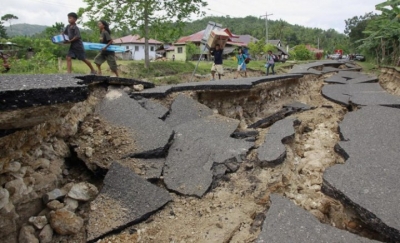Why do stars twinkle?

Stars are giant glowing balls of fire situated far away from us. Many of them are several times larger than our sun, but being very far away, appear as points of light. Stars themselves don’t twinkle but appear as steady points of light when seen from space where there is no atmosphere. The twinkling of stars as seen from ground is caused by the unsteadiness of the Earth’s atmosphere. When light from an extended source such as the Sun, Moon or the planets pass through the atmosphere, it does not appear to twinkle because the slight changes in apparent brightness in one part is usually compensated by light coming from another part of the celestial object. But when light from a point source like a distant star passes through the atmosphere the fluctuations in the light intensity is not compensated and the star appears to twinkle.

 The sky as seen from the Earth appears blue because of the scattering of sunlight by the Earth’s atmosphere. When sunlight reaches the Earth’s atmosphere, it hits suspended molecules of air and dust and gets scattered in all directions. Sunlight consists of light waves of varying wavelengths each of which is seen as a different colour. The size of the scattering molecules decides which colour is scattered most. Gas molecules in the atmosphere scatter blue colour the most. So during the day the sky appears blue because more blue light is deflected towards the earth. However, on the Moon, since there is no atmosphere, scattering of sunlight is negligible. So the sky appears black from the Moon.
The sky as seen from the Earth appears blue because of the scattering of sunlight by the Earth’s atmosphere. When sunlight reaches the Earth’s atmosphere, it hits suspended molecules of air and dust and gets scattered in all directions. Sunlight consists of light waves of varying wavelengths each of which is seen as a different colour. The size of the scattering molecules decides which colour is scattered most. Gas molecules in the atmosphere scatter blue colour the most. So during the day the sky appears blue because more blue light is deflected towards the earth. However, on the Moon, since there is no atmosphere, scattering of sunlight is negligible. So the sky appears black from the Moon.
 The tides are caused by the gravitational pull of the Moon on Earth’s oceans. In fact, the Moon’s gravitational pull attracts everything, even the land and mountains, though being rigid and fixed they do not move. But not so with the oceans. Being an unbroken stretch of water, spread over almost 70% of the Earth’s surface, the Moon’s pull can easily draw water away from one part and pile it up at another which show up as tides. However, this is not possible in a small body of water such as a lake. Here the total surface area and volume of water is too small to produce any perceptible change in the level as happens in tides.
The tides are caused by the gravitational pull of the Moon on Earth’s oceans. In fact, the Moon’s gravitational pull attracts everything, even the land and mountains, though being rigid and fixed they do not move. But not so with the oceans. Being an unbroken stretch of water, spread over almost 70% of the Earth’s surface, the Moon’s pull can easily draw water away from one part and pile it up at another which show up as tides. However, this is not possible in a small body of water such as a lake. Here the total surface area and volume of water is too small to produce any perceptible change in the level as happens in tides. language. In this way, other emotions too, are reflected through When you cross your arms, and lean away from another person to you are telling him that you want him to keep a distance, though of course, it may also mean that your arms are cold. If you look at a person in the eyes while speaking, it is a sign of honesty and straight forwardness. Looking away can mean you are lying, or that you don’t like the person. A person who shakes his legs constantly, or wets his lips is under stress. A person who leans towards you with clenched fists is quite likely to attract you! So you see, understanding body language helps you to understand the emotions of other people better.
language. In this way, other emotions too, are reflected through When you cross your arms, and lean away from another person to you are telling him that you want him to keep a distance, though of course, it may also mean that your arms are cold. If you look at a person in the eyes while speaking, it is a sign of honesty and straight forwardness. Looking away can mean you are lying, or that you don’t like the person. A person who shakes his legs constantly, or wets his lips is under stress. A person who leans towards you with clenched fists is quite likely to attract you! So you see, understanding body language helps you to understand the emotions of other people better. Some species of animals are especially clever at detecting human body language, both voluntary and involuntary. There is the instance of a horse called Hans, who seemed to be able to add, subtract, multiply, divide, work with fractions and do other intellectual tasks. If you asked him a question, Hans would reply by tapping his foot till the correct
Some species of animals are especially clever at detecting human body language, both voluntary and involuntary. There is the instance of a horse called Hans, who seemed to be able to add, subtract, multiply, divide, work with fractions and do other intellectual tasks. If you asked him a question, Hans would reply by tapping his foot till the correct








